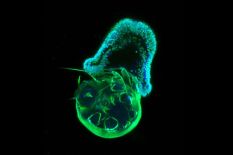Did Animal Evolution Begin With A Predatory Lifestyle?

New research findings on Aiptasia sea anemones point to early evolutionary events in multicellular organisms.
Were the first animals predators or filter feeders like the sponges living in today's oceans? And what role did symbiosis with algae play, as with reef-building corals? Surprising findings by a research group around Elizabeth Hambleton from DoME and Thomas W. Holstein of Heidelberg University on the development of sea anemones suggest that a predatory lifestyle moulded their evolution and had a significant impact on the origin of their nervous system. The researchers showed that the young life stages (larvae) of Aiptasia anemones actively fed on living prey and were not dependent on algae. To capture its prey, the anemone larvae use specialised stinging cells and a simple neuronal network.
Pictured is an early planula larval stage of the sea anemone Aiptasia (cyan nuclei and green stinging cells) preying on a crustacean nauplius (green) of the copepod Tisbe sp. | © Ira Mägele und Ulrike Engel
